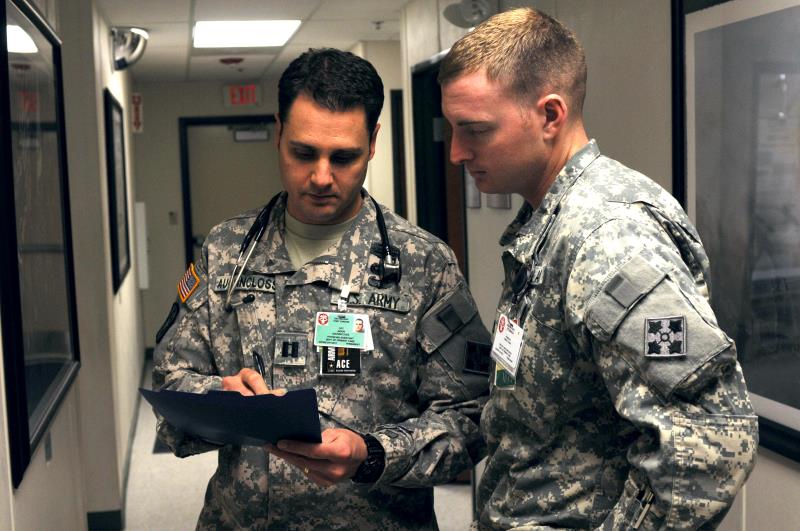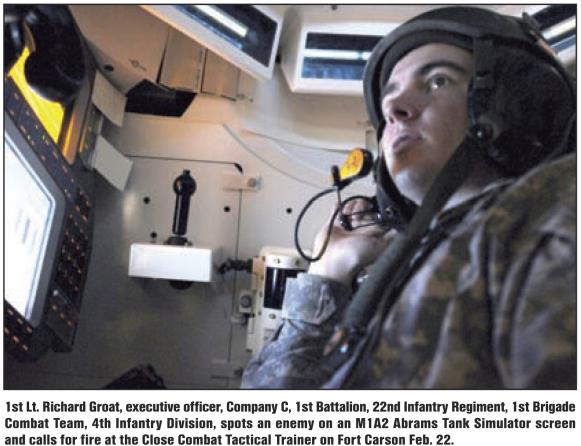![]() 1st Battalion 22nd Infantry
1st Battalion 22nd Infantry ![]()
News Articles February 2012
![]()

From left, Capt. Paul
Auchincloss, physician assistant, reviews a patient's file with
Pfc. Erik Hughes, medic, both assigned
to Headquarters and Headquarters Company, 1st Battalion, 22nd
Infantry Regiment, 1st Brigade Combat Team, 4th Infantry
Division,
Feb. 3, 2012, at the Wounded Warrior Medical Clinic on Fort
Carson, Colo. Auchincloss, a native of Zimbabwe, South Africa,
grew up
as a young man with the dream of providing medical treatment to
those in need. Since joining the Army in 1997, Auchincloss became
a commissioned officer, serving as a physician assistant, taking
care of injured soldiers.

Certain individuals provide
medical treatment to the sick and injured on a daily basis. These
heroes use their special skills
to save people's lives. This was the dream of one little boy
growing up in Rhodesia, Zimbabwe and South Africa,
who eventually made his way to "Raider" Brigade to take
care of Soldiers.
Capt. Paul Auchincloss,
physician assistant, assigned to Headquarters and Headquarters
Company, 1st Battalion,
22nd Infantry Regiment, 1st Brigade Combat Team, 4th Infantry
Division, grew up knowing his dream was to become
a health care provider.
Auchincloss said he moved around
a lot growing up, eventually settling in Pietermaritzburg, South
Africa, where he graduated
high school in 1992. After graduating and not being eligible for
medical school, he decided to pursue a career in aviation,
while continuing to seek medical training. A combination of
scholastic achievements and changing ethnic climate posed
a considerable challenge.
As a result, Auchincloss said he
went into aviation schooling, where he graduated at the top of
his class, becoming one
of Zimbabwe's youngest commercial pilots at the age of 19, and
being named pilot of the year and instructor pilot of the year
by the Mashonaland Flying Club in Zimbabwe in 1993 and 1994
respectively.
Auchincloss said he flew hunters
and tourists in and out of neighboring countries until he moved
to the United States in 1995.
While living in America, Auchincloss decided to once again pursue
his dream of becoming a doctor, thanks to the persistent
nudging and prodding provided by his wife, who also had many
similar goals and aspirations.
"I began to take Emergency
Medical Technician and Shock Trauma Technician classes when I
lived in Harrisonburg, Va.,
14 days after entering the United States — thanks to the
hard work and preparation of my devoted spouse," said
Auchincloss.
"I also specialized in Heavy Vehicle Extrication, Vertical
Rope Rescue and Cave Rescue."
The devoted medic received a
commendation for lifesaving excellence and was named rookie EMT
of the year in 1996
by the Harrisonburg Rescue Squad.
In 1997, Auchincloss enlisted in
the Army, with the goal of earning money for college and
supporting his Family.
Auchincloss said he enlisted as a field artilleryman and climbed
through the ranks to sergeant first class, after a brief change
in military occupational skill to that of intelligence analyst.
From there, he continued his education in medical studies in
2005,
where he enrolled into college at the Virginia Commonwealth
University and later transferred
to the University of Virginia School of Nursing.
Just prior to degree completion,
he was picked up by the Army's Interservice Physician Assistant
Program, through which
he was commissioned a U.S. Army officer and became a physician
assistant.
"The Noncommissioned
Officer Corps is the 'Backbone of the Army,'" said
Auchincloss. "I believe that it is this insight
and experience that makes me a better leader and officer as it
provides a different perspective, which is useful in the medical
community."
"I watched many of
Auchincloss' lectures to groups of medics and corpsmen; his
mastery in the subject of medicine,
and ability to communicate it in an entertaining style, reflected
his passion of the subject," said Lt. Cmdr. Ralph Leonard,
staff physician, assigned to U.S. Navy Hospital at Camp Lejeune,
N.C. "But actually watching him with patients showed
how much he truly cared about Soldiers."
During Raider Brigade's 2010
deployment to Afghanistan, Auchincloss worked hard to take care
of Soldiers.
"His remarkable dedication to patient care was manifested in
several ways at our forward operating base," said Leonard.
"I saw him pull all-nighters several times when patients
were critically ill; when we weren't busy with direct patient
care,
he used that time for building a very functional battalion aid
station."
Even when times got tough,
Auchincloss pushed on and continued to treat and work with
Soldiers.
"While working with Auchincloss, there was a (Soldier) who
was killed by an improvised explosive device,"
said Leonard. "He went to the combat outpost where that
Soldier was stationed ... participated in crisis intervention
counseling,
and supported the Soldiers affected by the death."
In his service to his nation,
Auchincloss helped countless Soldiers before and after his
deployment with Raider Brigade.
It is because of his love of working with Soldiers that he plans
to continue to serve in the Army and keep treating Soldiers, he
said.
"Becoming a physician assistant is an honor. I've been an
enlisted Soldier, and now, I get to take care of those
Soldiers,"
said Auchincloss. "I've got a soft spot for them; they do
wonderful things for this country, so being a physician assistant
is one of the best things that I can ask for."
**********************
![]()


Four Soldiers filled the M1A2
Abrams Tank Simulator to capacity. Screens and buttons
illuminated the armor crewmen
as they donned their Army combat helmets and checked their
radios. Settled into their positions, the team worked together
to eliminate simulated enemies appearing on the screens.
"Regular" Soldiers
assigned to Company C, 1st Battalion, 22nd Infantry Regiment, 1st
Brigade Combat Team, 4th Infantry Division,
conducted simulation training at the Close Combat Tactical
Trainer building on Fort Carson Feb. 21-23.
The Company C Soldiers conducted
the simulations for gunnery and tank qualification without
burning resources
used during live-fire training, said 1st Lt. Richard Groat,
Company C executive officer.
"Digital training is
crucial, because a live-fire would be like going out to shoot a
rifle with each bullet costing thousands of dollars,"
Groat said. "This way, Soldiers are given the chance to
excel with their weapons without worrying about ammunition
shortages."
During the simulation, Soldiers
used communication and teamwork to successfully eliminate enemies
and progress through the training.
"Working as a team, communicating and talking loud enough so
our other teammates could hear us was essential to complete
the simulation training," said Pvt. Michael Alien, armor
crewman. "This simulation required me to use pretty much
every skill
I've learned since basic training."
While the simulation lacked the
intensity of a live-fire exercise, the crewmembers used the more
relaxed atmosphere to
gain confidence in their own skills and their comrades, said Pvt.
Neil Tickle, armor crewman.
"Another bonus of this
training is that we are getting more familiar with our crew and
how they operate, so we can
run more smoothly," said Tickle.
The simulation seems like a
video game, but the operations are the same as a real tank, said
Alien.
"The whole crew gets a feel of what it's like to maneuver,
shoot and fight with the tank," said Groat. "I think
the Soldiers
really like this training because it's fun and what they are here
to do."
Alien said his team members
gained a better understanding of how they would work together to
perform their battle drills
during their upcoming live-fire exercise and during real-world
operations.
By the end of the event, each
crew successfully navigated the virtual world and eliminated its
enemies.
"Working together is the only way a crew can operate,"
said Tickle. "The better the crew can read each other,
the more likely their mission will be a success."
After completing their
simulation training, the Regulars will begin range qualification
to certify their tank crews.
"In the end, we are hoping to gain well-trained, lethal
troops — ones that are proficient with their individual
warrior skills,
as well as their crew tasks," said Groat.
Home | Photos | Battles & History | Current |
Rosters & Reports | Medal of Honor | Killed
in Action |
Personnel Locator | Commanders | Station
List | Campaigns |
Honors | Insignia & Memorabilia | 4-42
Artillery | Taps |
What's New | Editorial | Links |